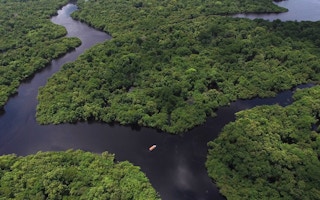In early October, shortly after Hurricane Maria made landfall in Puerto Rico, Tesla CEO Elon Musk said on Twitter that his company could, given the opportunity, rebuild the island’s electrical grid using solar power. Coming in the midst of so much human suffering, it was a bold claim.
But from a technological perspective, the timing was perfect. By late October, solar panels and high-capacity batteries had been installed at San Juan’s Hospital del Niño, and additional projects are in the works.
This type of response to a natural disaster – replacing a fossil-fuel-reliant power grid with renewable energy – should be applauded. But no matter how clean and efficient renewable energy sources may be, they will never fully mitigate the climatic effects that are bringing more hurricanes like Maria ashore.
There is another way to do that, and it is far cheaper than what Musk has proposed.
Puerto Rico is home to one of the most efficient and inexpensive tools available in the fight against climate change: rainforests. On the island’s eastern tip, the nearly 29,000-acre El Yunque National Forest is one of the Caribbean’s most important systems for capturing and storing carbon.
Maria destroyed the forest, too. But tech CEOs have not tweeted about restoring that resource, because, at the moment, they see no viable business model for saving trees.
But what if such a model did exist? What if there were ways to make tropical forests worth more alive than dead?
Global leaders have been pondering this question for years. And, at UN climate talks, they have come up with a novel solution: an initiative called Reducing Emissions from Deforestation and Forest Degradation (REDD+). The idea is simple: with the right incentives, people, governments, and industries will preserve and restore tropical forests, rather than plow them under. In return, the world gets more carbon sinks to soak up greenhouse gasses.
REDD+, which has been around in various forms for nearly a decade, provides a payment structure for preservation and restoration efforts. By putting an economic value on forests for the role they play in large-scale carbon capture and storage, REDD+ allows standing trees to compete with lucrative land uses – such as logging or agriculture – that result in deforestation.
The first large-scale REDD+ program, an agreement between Norway and Brazil, was initiated in 2008. Norway agreed to provide $1 billion in “performance-based payments” to Brazil for successfully protecting its rainforests. The money from Norway was released in installments, as Brazil conserved its forests.
The results were impressive: Brazil reduced the average rate of Amazon deforestation by over 60% over the last decade, absorbing about 3.6 billion tons of carbon dioxide, more than any other country. And Norway was able to help mitigate global carbon dioxide emissions.
“
There is danger in delay. In the two years since the Paris climate agreement was adopted, deforestation increased sharply in Indonesia and parts of the Amazon, where much of the world’s largest and most vital tropical forests stand.
But, despite the success of the pilot partnership, the REDD+ program today is in dire need of capital. In many ways, the solution is similar to Musk’s solar proposal in Puerto Rico. Only this time, the innovation is not technical, but financial.
Creating a market for REDD+ credits would create investment opportunities in tropical forest preservation for heavily polluting companies and industries. With an adequate policy framework, REDD+ credits could be offered through existing compliance markets – such as the carbon credit markets in California or South Korea – unlocking billions in additional capital for reforestation efforts.
Developing such a framework would also enable REDD+ to become part of future compliance systems, like the one being developed by the global airline industry to cap emissions, or the carbon-permit market that China plans to launch later this year.
Integration into these markets could also tap new funding streams for forest conservation and reforestation, as it would allow financial intermediaries, like the REDD+ Acceleration Fund, to connect REDD+ projects directly with the private sector.
At the moment, most of this is aspirational. REDD+ is merely a set of guidelines, and a forest credit market will require rules and standards to govern how protection and reforestation allowances are allocated to buyers and integrated into current markets.
Global leaders gathering this week for the UN climate change conference in Bonn, Germany, can aid these efforts by continuing to support the development of effective and transparent accounting mechanisms for REDD+ projects.
There is danger in delay. In the two years since the Paris climate agreement was adopted, deforestation increased sharply in Indonesia and parts of the Amazon, where much of the world’s largest and most vital tropical forests stand. According to the Union of Concerned Scientists, tropical deforestation is responsible for three billion tons of additional atmospheric CO2 annually – more than the world’s entire transportation sector.
No technology is as effective at storing carbon as tropical forests, and saving and restoring them offers one of the cheapest large-scale forms of emissions abatement or capture, while providing a host of other environmental and social benefits.
To take advantage of this crucial hedge against a warming planet, more trees must remain standing. For those of us who believe that a forest credit market could provide critical means of protecting our planet our Musk moment is here. We must be similarly bold.
© Project Syndicate 1995–2017
To continue reading, subscribe to Eco‑Business.
There's something for everyone. We offer a range of subscription plans.
- Access our stories and receive our Insights Weekly newsletter with the free EB Member plan.
- Unlock unlimited access to our content and archive with EB Circle.
- Publish your content with EB Premium.









